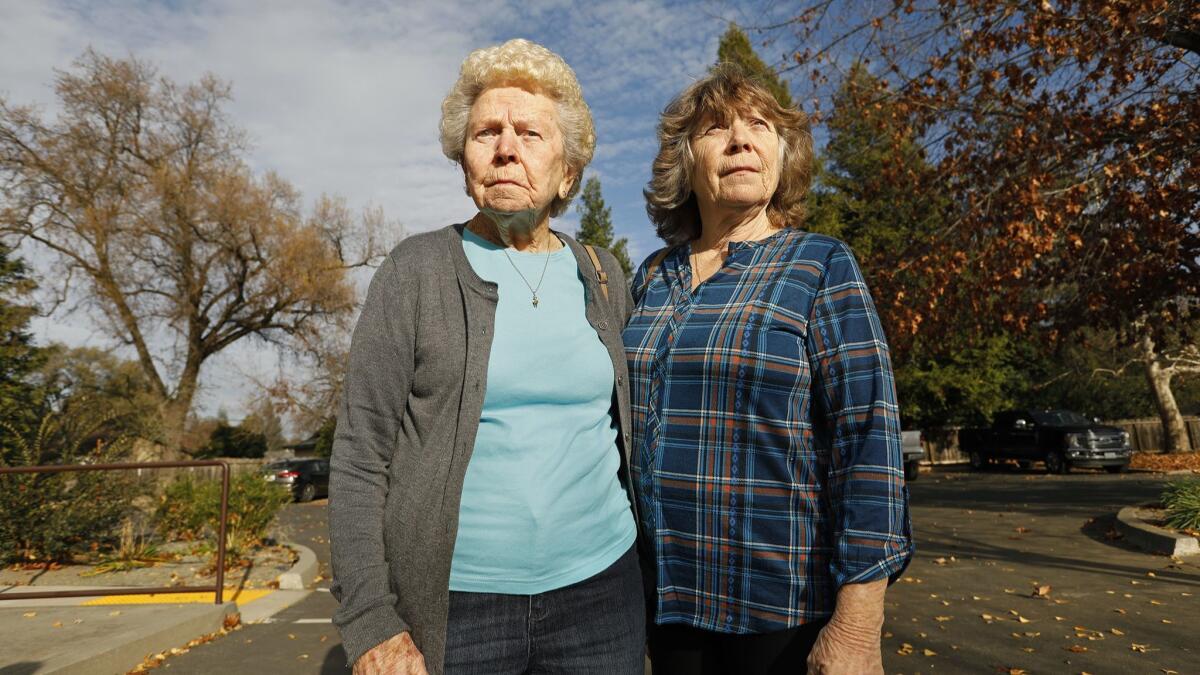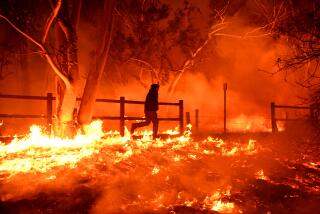Camp fire survivors accuse PG&E of ‘callous and despicable disregard’ for safety

- Share via
Reporting from Chico, Calif. — One lawsuit points to a small metal hook on an electrical transmission tower as the culprit in the devastating Camp fire. When it failed, the suit alleges, an uninsulated wire touched the tower, caused sparks and ignited the blaze.
Other suits filed after California’s deadliest wildfire blame the general decay of the region’s electrical infrastructure and the failure to trim trees and brush that grew too close to poles and power lines.
While authorities have yet to determine an official cause of the Camp fire, at least 20 lawsuits have been filed against Pacific Gas & Electric, accusing the utility of allowing its equipment to spark the blaze that killed 86 and displaced up to 50,000 people in Butte County.
The most recent suit blasts a corporate culture that allegedly places “reputation above public safety” along with advertising that “promotes a false and misleading picture” of Northern California’s electricity supply.
That suit, filed Monday evening on behalf of 93-year-old Lila Williams and her 66-year-old daughter Louise Howell, accuses PG&E of “callous and despicable disregard for the safety of California communities.”
The lawsuit said that while PG&E professed an emphasis on safety, it failed to bankroll necessary improvements. “The people of the State of California have paid for corporate greed with the lives of their loved ones, their homes and their most cherished belongings,” the suit alleges.
The lawsuits come as the utility defends itself against a blizzard of litigation that followed a deadly string of Northern California fires just 14 months ago.
PG&E is currently being sued for what the California Department of Forestry and Fire Protection lists as six of the deadliest and most destructive fires in state history that, together, claimed 127 lives, scorched more than 400,000 acres and destroyed more than 28,000 structures.
PG&E officials declined to comment Tuesday on specifics of the Camp fire litigation.
“The safety of our customers and the communities we serve is our highest priority,” company spokeswoman Andrea Menniti said in an email. “The cause of the Camp Fire is still under investigation. We are aware of lawsuits regarding the Camp Fire. Right now, our focus is on assessing infrastructure, safely restoring power where possible, and helping our customers recover and rebuild.”
In a filing with the Securities and Exchange Commission the day after the Camp fire roared through the small towns of Paradise, Magalia and Concow, the San Francisco-based utility warned of the disaster’s effect on its bottom line.
The company had renewed its liability insurance for “wildfire events” at $1.4 billion, the filing said. That amount was supposed to cover disasters from Aug. 1, 2018, through July 31, 2019.
“While the cause of the Camp Fire is still under investigation,” the filing said, “if the Utility’s equipment is determined to be the cause, the Utility could be subject to significant liability in excess of insurance coverage.” Such liability “would be expected to have a material impact on PG&E Corporation’s and the Utility’s financial condition, results of operations, liquidity, and cash flows.”
The Camp fire lawsuits, which were filed on behalf of more than 450 people, businesses and trusts so far, do not ask for the utility to pay a specific amount. Instead, they demand that PG&E repay the victims for economic losses, “non-economic harm,” loss of wages, medical expenses and attorney’s fee. They ask for a jury trial. And they want PG&E and all other defendants to “stop their continued violations.”
Andrew Bradt, a professor of law at UC Berkeley who specializes in civil court procedure, said the Camp fire suits will probably be consolidated before a single judge in the near future. A single lead lawyer or a committee of lawyers could be appointed to guide the litigation.
“The goal for the court is to preserve everyone’s rights without being overwhelmed,” Bradt said. “The challenge for the courts is always to streamline the litigation. They don’t have the resources to deal with them all separately.”
Many of the Camp fire suits already have striking similarities such as a catalog of past wildfires, electrical fires and explosions for which PG&E has paid hefty fines and legal settlements.
Among those disasters: The 1994 Trauner fire in Nevada County, for which the utility “was convicted of 739 counts of criminal negligence and required to pay $24 million in penalties.” And the 2010 explosion in the Bay Area suburb of San Bruno, which killed eight, injured 58, destroyed a neighborhood and saw the California Public Utilities Commission slap PG&E with a $1.6-billion fine.
“We thought after San Bruno we would never have to see another calamity again,” attorney Frank Pitre said during a news conference in Chico on Tuesday afternoon.
Pitre is the lead attorney in the Howell and Williams case and was involved in the San Bruno litigation. In addition to civil cases against the utility, PG&E was convicted on six felony counts — one of lying to the National Transportation and Safety Board and five pipeline safety violations.
Pitre displayed post-San Bruno ads in which PG&E vowed that it would replace and modify transmission lines and set up fire weather stations. Then the Butte fire hit in Calaveras County in 2015.
“Two dead,” Pitre said. “PG&E continued to promote that safety was their first concern.”
Then came the North Bay fires in 2017 — 17 different blazes that raced through Napa, Sonoma, Solano and Mendocino counties and included the Atlas fire, which killed six, and the Tubbs fire, which took 22 lives.
“A judge ordered that, if they continued to promote safety, they had to include that they had been convicted of six felonies,” Pitre continued.
The lawsuit filed Monday evening alleges that PG&E has diverted “necessary safety related expenditures into funding corporate bonuses, boosting shareholder profits, and/or fueling advertising campaigns — while ignoring the serious and irreparable nature of the public safety threat posed by its aging infrastructure and ineffective vegetation management practices.”
Pitre said in an interview that his firm plans to file 60 to 100 Camp fire lawsuits in coming months, including several wrongful death suits on behalf of families that lost loved ones.
When plaintiff Louise Howell, who lived in Concow, saw the massive plume of smoke early Nov. 8, she called her mother to warn her, then grabbed her computer and her late father’s guitar. As she packed them into her car, she heard crackling; plants and tires around a little cabin in her yard were on fire.
She called 911. The dispatcher put her through to Cal Fire.
“I remember them saying, ‘I don’t think we can help you,’ ” she said in an interview. “Right about then, I heard glass break. My curtains were in flames, and the flames went into the living room. … I screamed for my dog. He didn’t come.”
She pauses. Begins to cry. “The fence down my driveway was fully engulfed. I had to go. When I was driving out, a motor home my son had was a big ball of flames. I didn’t look anymore. I just drove.”
Until she couldn’t. At one point, Howell said, she fled from her car and stood in the shallow water at the top of Lake Concow. When she finally got to safety, her house was gone. Her mother’s house was gone; so were a granddaughter’s and a grandson’s. Four friends were dead. Her cat, Liza, and her dog, Satriani, were gone.
She sued the utility, she said, because “I want to stop PG&E from doing what they’re doing. I don’t want them to hurt anybody else.”
La Ganga reported from Los Angeles and Marcum reported from Chico.
Twitter: @marialaganga
Twitter: @DianaMarcum
More to Read
Sign up for Essential California
The most important California stories and recommendations in your inbox every morning.
You may occasionally receive promotional content from the Los Angeles Times.












